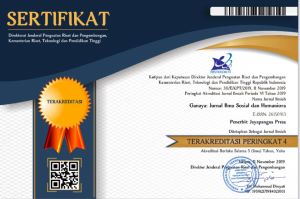Ethical Education Values in Balinese Women’s Traditional Clothing
DOI:
https://doi.org/10.37329/cetta.v7i4.3760Keywords:
Ethical Education Values, Balinese Women, Traditional ClothingAbstract
Balinese traditional clothing is an essential element representing the Balinese’s cultural identity. More than just a body covering, these clothes are filled with ethical, aesthetic, and spiritual values that reflect the teachings of Hinduism. This research aimed to reveal the meaning and value behind the use of traditional clothing in religious ceremonies, especially among Balinese women. The research used a qualitative method with a direct observation approach to indigenous people. Data were collected through observation, in-depth interviews, and documentation, then analyzed descriptively. The results showed that traditional clothing is not only a symbol of respect for ancestors but also a symbol of purity, dignity, and respect for the gods. Balinese women adhere to a dress code emphasizing modesty, neatness, and color selection according to religious symbolism. In addition to showing physical beauty, traditional clothing reflects adherence and loyalty to Balinese Hindu teachings. Furthermore, traditional clothing plays a role in maintaining social harmony in indigenous communities. Each element of clothing has symbolism that reflects the relationship between humans, nature, and the gods. In conclusion, traditional Balinese clothing serves as a spiritual expression and a medium for preserving traditions and strengthening social relationships. Balinese women’s dress code in the traditional context reflects the harmonious balance between spirituality, tradition, and social interaction in Balinese life.
References
Ardana, I W. (2012). Makna Simbolik Busana Adat Bali dalam Konteks Keagamaan. Denpasar: Bali Pustaka.
Ardika, I W. (2016). Sejarah Kebudayaan Bali. Denpasar: Universitas Udayana Press.
Dewi, N. L. P. Y. (2023). Tren Modifikasi Sanggul Perempuan Bali: Antara Estetis dan Etis. Jnanasiddhanta: Jurnal Teologi Hindu, 5(1), 71-80.
Jaya, I. G., Weda, I. G. L. N., & Pramana, I. B. K. Y. (2023). Etika Berbusana Adat Ke Pura Dalam Membangun Karakter Remaja Di Dusun Tambang Eleh Kabupaten Lombok Barat. Padma Sari: Jurnal Ilmu Pendidikan, 2(02), 122-132.
Jaya, I. K. A., Perbowosari, H., & Suci, I. G. S. (2021). Penyimpangan Nilai-Nilai Etika Dalam Berbusana Adat Ke Pura Di Desa Penarungan Kecamatan Mengwi Kabupaten Badung. Metta: Jurnal Ilmu Multidisiplin, 1(1), 7-19.
Jaya, I. W. D., & Wisarja, I. K. (2024). Pendidikan Tri Hita Karana Dalam Prosesi Nunas Babungah Petapakan Ida Bhatara Ratu Gede Dan Ida Bhatara Ratu Lingsir Desa Adat Tegal Suci Desa Sebatu Kabupaten Gianyar. Metta: Jurnal Ilmu Multidisiplin, 4(3), 33-49.
Kempers, A. J. B. (1991). Monumen Bali Kuno: Kajian Arkeologi Seni dan Sejarah. Jakarta: Penerbit Djambatan.
Koentjaraningrat. (1993). Kebudayaan, Mentalitas, dan Pembangunan. Jakarta: PT Gramedia Pustaka Utama.
Parwati, N. L. P. (2018). Etika Perilaku dalam Pura: Suatu Kajian dalam Masyarakat Bali. Yogyakarta: Gadjah Mada University Press.
Saraswati, I. A. (2017). Pura dan Kehidupan Sosial di Bali. Denpasar: Udayana Press.
Sariyani, N. N. (2019). Pakaian Adat Ke Pura Pada Generasi Remaja Hindu Di Desa Sari Mekar (Perspektif Sosial, Budaya Dan Religius). Jurnal Widya Sastra Pendidikan Agama Hindu, 2(2), 26-36.
Sedana, I. M. (2023). Tradisi Seni Tari Pencak Silat Depok Sruti Dalam Rangkaian Upacara di Pura Mas Penyeti Buleleng:(Kajian Pendidikan Agama Hindu). Jurnal Penelitian Agama Hindu, 7(1), 108-120.
Suartini, D. M. (2022). Etika Berbusana Adat Bali Dalam Persembahyangan Di Pura Mandira Taman Sari Kota Palopo. Bawi Ayah: Jurnal Pendidikan Agama dan Budaya Hindu, 13(1), 82-99.
Sudarsana, I W. (2015). Etika Adat Bali dalam Perspektif Budaya dan Agama. Denpasar: Pustaka Bali.
Sudarta, N. (2015). Tradisi dan Agama Hindu di Bali: Penerapan Etika dan Moral dalam Kehidupan Sehari-Hari. Denpasar: Dharma Media.
Sumertayasa, K. Y., Nerawati, N. G. A. A., Giri, I. M. A., Setyaningsih, F., & Suarnaya, I. P. (2023). Nilai Pendidikan Agama Hindu dalam Pementasan Tari Sang Hyang Dedari. Metta: Jurnal Ilmu Multidisiplin, 3(1), 70-83.
Triawati, K. (2022). Kebaya dan Pura: Identitas Gaya Hidup Budaya Perempuan Bali Di Toili. Jurnal Pariwisata PaRAMA: Panorama, Recreation, Accomodation, Merchandise, Accessbility, 3(1), 32-41.
Wardani, N. L. P. (2018). Tradisi Busana Bali: Keteraturan dan Simbolisme. Denpasar: Yayasan Kebudayaan Bali.
Warta, I. N. (2024). Etika Estetika Dan Filosofi Berbusana Sembahyang Dalam Ajarah Hindu. Widya Aksara: Jurnal Agama Hindu, 29(1), 77-90.
Wiana, I K. (2017). Kesucian dan Kesopanan dalam Tradisi Bali. Denpasar: Penerbit Dharma Bhakti.
Wibawa, I. G. P. A. M., & Sudarsana, I. K. (2019). Nilai-Nilai Pendidikan Agama Hindu Dalam Pementasan Barong Ida Ratu Gede Dalem Pada Upacara Nuwur Di Pura Dalem Desa Adat Tangeb Badung. Cetta: Jurnal Ilmu Pendidikan, 2(2), 253-270.
Yudarta, I K. (2019). Martabat Wanita Bali dalam Perspektif Adat dan Agama. Gianyar: Yayasan Adat Bali.
Downloads
Published
How to Cite
Issue
Section
License
Copyright (c) 2024 I Ketut Sudarsana

This work is licensed under a Creative Commons Attribution-ShareAlike 4.0 International License.
An author who publishes in the Cetta : Jurnal Ilmu Pendidikan agrees to the following terms:
- Author retains the copyright and grants the journal the right of first publication of the work simultaneously licensed under the Creative Commons Attribution-ShareAlike 4.0 License that allows others to share the work with an acknowledgement of the work's authorship and initial publication in this journal
- Author is able to enter into separate, additional contractual arrangements for the non-exclusive distribution of the journal's published version of the work (e.g., post it to an institutional repository or publish it in a book) with the acknowledgement of its initial publication in this journal.
- Author is permitted and encouraged to post his/her work online (e.g., in institutional repositories or on their website) prior to and during the submission process, as it can lead to productive exchanges, as well as earlier and greater citation of the published work (See The Effect of Open Access).
Read more about the Creative Commons Attribution-ShareAlike 4.0 Licence here: https://creativecommons.org/licenses/by-sa/4.0/.





